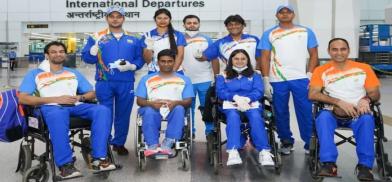Indian success story: Para-athletes got a level playing field with able-bodied athletes with government, private support
A level playing field for para and able-bodied athletes, encouraging support from the government, timely hand-holding by private players, mushrooming of exclusive arenas and incentives contributed to the impressive showing by in Tokyo Paralympics for the disabled where it had its best-ever showing of 19 medals, including five golds, The Indian Express said in a despatch

A level playing field for para and able-bodied athletes, encouraging support from the government, timely hand-holding by private players, mushrooming of exclusive arenas and incentives contributed to the impressive showing by in Tokyo Paralympics for the disabled where it had its best-ever showing of 19 medals, including five golds, The Indian Express said in a despatch.
On Sunday, shuttler Krishna Nagar did a Neeraj Chopra, with his win in the final giving India its fifth gold medal. And with 19 medals overall, India finished 24th on the medals tally.
India’s count was boosted by the four-medal sweep in badminton, a sport making its debut, and four more in new categories in other disciplines. However, there is more to the para-leap of a nation that had a grand total of just 12 medals before Tokyo. Javelin thrower Sumit Antil, 23, who broke three world records on way to gold, hints that his training and exposure wasn’t too different from Indian sports’ new poster-boy Neeraj.
“In 2018, some para athletes also got a chance to train in Finland with other athletes like Neeraj Chopra and that was a huge mental motivation for us. We knew that we were being treated the same as the able-bodied athletes. I got a chance to compete in Italy, France, Tunisia in the last three years and it also made me understand the different conditions, a thing which will also help in preparation for the 2024 Paris Olympics,” Antil was quoted as saying by the paper.
Antil got a Rs 7 lakh prosthetic blade, equipment and biomechanics support, thanks to the Sports Authority of India and NGO Go Sports Foundation.
Says silver medallist discus thrower Yogesh Kathuniya: “Apart from facilities, governments now see para-athletes’ achievements the same way as normal athletes in terms of cash awards and jobs. This has added to our confidence.” Like Chopra, Antil got Rs 6 crore from the Haryana government for his javelin gold.
Besides, the entire 54-member Indian contingent — the largest ever at the Paralympics — was a part of the Central Government’s flagship Target Olympic Podium Scheme (TOPS). The Government spent almost Rs 8.2 crore on para-sports from 2018-19 to 2021-22, the Sports Minister told Lok Sabha this year.
Besides, the spending was athlete-specific and came at the right time.
The Sports Ministry funded the installation of a computerised digital target at gold and bronze medal-winning shooter Avani Lekhara’s home, apart from taking care of the heavy costs of her air rifle, ammunition and accessories. Under TOPS, wheelchair silver medallist Bhavina Patel got an updated “practice partner” robot that helped her during the lockdown last year.
The results were there to see. Patel made it to the podium in a sport long dominated by the Chinese, beating World No 3 Zhang Miao to win silver in the women’s Class 4 (wheelchair) singles event.
“So many people get scared when the opponent is Chinese. By beating them, I proved that they too are human,” she says after becoming the only Indian table tennis player to have won an Olympic or Paralympic medal.
Public-private partnerships, too, played a role. Working with para-athletes since 2008, GoSports Foundation was affiliated with 11 of the 19 para-athletes for Rio 2016, and continued its work ahead of the Tokyo Games, when the Sports Ministry got in touch.
“They’d call and ask us what all we’ve done for a particular athlete so that there is no duplication,” says GoSports’ executive director Deepthi Bopaiah. “So, for Avani, the Government looked after certain training and competitions abroad, and we paid for her coaching here. For Sumit Antil, we looked after his prosthetics and they took care of his travel to tournaments.”
This time, another private initiative, Olympic Gold Quest (OGQ), got involved in supporting para-athletes — 10 of whom picked up medals, The Indian Express said.
And then, training got more streamlined. “Earlier, we had to book time slots to play, but now we have a dedicated professional academy with all facilities and sports science equipment,” says para-badminton head coach Gaurav Khanna about his facility in Lucknow. “We can decide when to schedule practice. And then there is the gym, steam bath, ice bath, hydrotherapy…everything a professional athlete needs.”
Facilities like the SAI campus in Gandhinagar and the table tennis centre in Indore too are equipped for para-athletes with coaching methods having changed over the years.
The opening of more avenues and increased incentives have seen participation spike. There were around 700 para-athletics at the nationals in 2015, and 1,800 in 2019.
Says table tennis star Patel: “Earlier, people didn’t know what the Paralympics were. It’s improved, but it’s not enough. There are still places where people think, ‘yeh bechare hai.’ That has to change. Hum bechare nahin hai (We are not helpless). Look at what we’ve achieved. Our Paralympians have brought more medals than Olympians. And there’s more we can still achieve.”
Incidentally, India finished 48th on the medals tally in the Tokyo Olympics, with a best-ever haul of seven, including Chopra’s gold.
Says three-time Paralympics medallist Devendra Jhajharia: “We still can improve as medals have only come in athletics, shooting, badminton and table tennis but Tokyo has set the momentum for us.”









Post a Comment